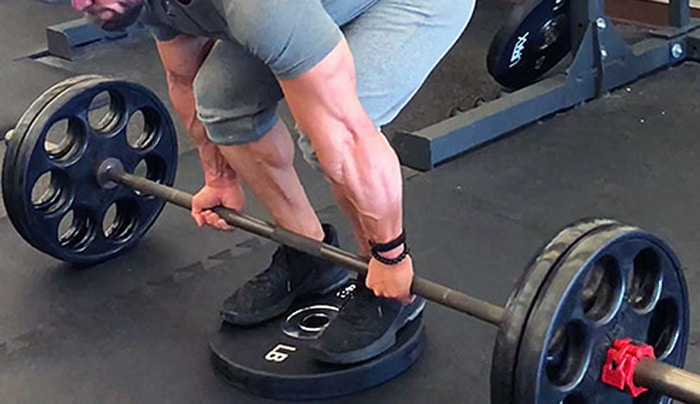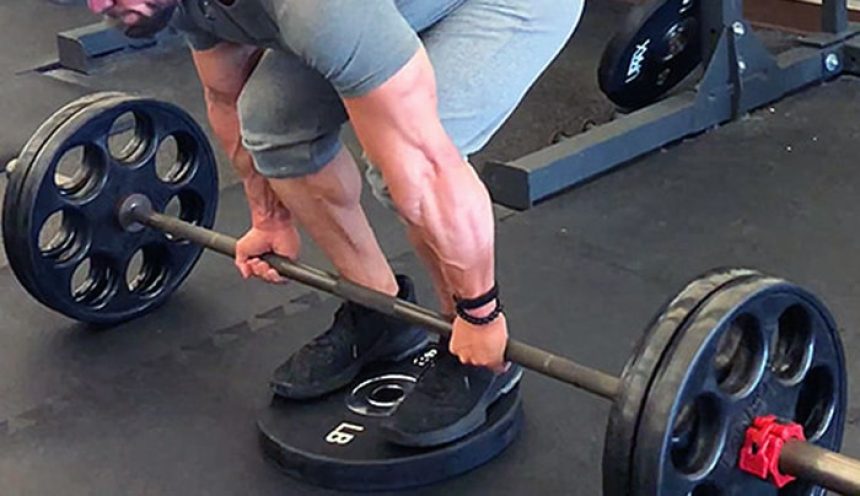When you’re pushing to break your max deadlift, you need to deadlift more. Seems obvious but sometimes we miss what’s right in front of our faces.
But not only do you need to deadlift more, but you need to deadlift smarter also.
Because when you’re deadlifting with weights hovering around 90% 1 RM, tendencies creep into your deadlift that are not obvious when you’re pulling sub-maximal weights.
And these hitches can hold you back from lifting more weight and in a worst-case scenario, can cause injury. This is why targeted deadlift accessory exercises to crush those weaknesses are your best friends.
Common deadlift ‘weaknesses’ include
- The bar moving ‘slow’ off the floor
- Rounding of the spine (upper and lower) or the bar drifting away from the body due to the lack of upper back tightness and strength
- Locking out and finishing with your glutes once the bar passes your knees
The next time you’re pulling heavy, pay attention to your form (or video it or get a friend to), to see if any of these are happening.
If it is, use the following exercises to attack those weaknesses because your weaknesses will not go away by themselves. You need to do something about it.
Slow off the Floor
When you’re slow from the floor, you need to build strength and power from the bottom position, so you can blast past this sticking point.
A. Deficit deadlifts
Don’t go crazy on the deficit. Standing on a 45-pound weight plate is enough Too much of a deficit leads to the lower back rounding in the bottom position (depending on hamstring and hip mobility.)

And too much lower back rounding while deadlifting is a no-no.
Adding the range of motion makes the initial pull more difficult which helps your regular deadlifts feel easier when you got back to them.
Why this helps
Builds strength from the bottom position.
Weight to use
Start with a weight between 70-80 1RM.
Sets and reps
This is best performed as your second deadlift exercise for the training week. Do anywhere from 3-5 sets, 3-6 reps, keeping the reps between 10-25.
Training suggestion
If you’re looking for some extra booty action, pair this with a hip extension exercise. For example,
1A. Deficit deadlift 3 sets 6 reps
1B. Incline back extensions 10 reps
Lear more about deficit deadlifts.
B. Speed deadlifts
Also known as technique deadlifts.
Set up and pull like it’s your 1 RM max on the bar and ignore how light the barbell feels. If it’s 50% lighter than your 1 RM then the bar should move twice as fast.
Why this helps
Builds power from the bottom position to blast past this sticking point.
Weight to use
This exercise is not about the weight on the bar, it’s about how fast it moves from the floor. Use anywhere from 40-70% of your 1 RM. If the bar feels sluggish off the floor, it’s too heavy.
Sets and reps
3 sets for 3-6 reps.
Training suggestion
To keep the upper tight and the bar close to the body when you’re exploding off the floor, consider pairing with an upper back exercise. For example,
1A. Speed deadlifts 3 sets 5 reps
1B. Lat straight arm pull down 12-15 reps
Lockout Strength
These exercises work on hip extension strength, which are essential for locking out the top part of your deadlift.
A. Rack pulls
The reduced range of motion allows you to load up, which in turn adds load to your sticking point. Because when you have a sticking point you need to attack it.
Why it helps
Not only does in add load to your sticking point helping it when it comes to your regular deadlifts but it improves your grip strength which enhances your readiness for heavy lifts.
Weight
Use over 90% of 1 RM.
Sets and reps
Use this as your main deadlift for your training session rather than an accessory movement. Do 3- 5 sets of 3-6 reps, keeping your total reps between 10-25 reps dependent on the load you use.
Training suggestion
1A. Rack pulls 4 sets 5 reps
1B. Half kneeling hip flexor mobilization -6 reps
B. Banded broad jump
Directly training your glutes with power hip extension exercises like broad jumps will help the barbell accelerate once the bar crosses the knees.
This banded version takes some impact of your knees and provides a little added resistance.
Why this helps
This adds power and pop to your hip extension and improving your strength for lockout.
Weight
Take note of the band set up in the video.
Sets and reps
3 sets of 3-5 reps.
Training suggestion
Power exercises like this demand a lot from the body so pair with a mobility exercise for recovery purposes work well. For example
1A. Banded broad jump 3-5 reps
1B. Passive leg lowering 10 reps each side
Upper back strength
The upper back plays an important role in pulling the bar in a straight path and keeping a neutral spine under heavy load.
A. Double racked Bulgarian split squat
The double racked kettlebell position puts a premium on upper back strength. And the kettlebells will give you instant feedback if you round your shoulders forward.
The split squat is just for fun. You like single leg work, right?
Why it helps
Develops strength in the upper back while the split squat helps with leg drive as this trains the quads and the hips. Leg drive is essential for pulling heavy.
Weight
Depends on your strength and your access to kettlebells. Anywhere from 12 -20 kg works
Sets and reps
This is best used as a hypertrophy movement after your main lift. Anywhere from 8- 15 reps for 2- 4 sets will have you walking funny the next day.
Training suggestion
For a real upper back whammy, pair with a single arm row. As a bonus, this will smoke your grip also.
1A. Double racked Split squats 8-12 per leg
1B. Single-arm row 8-15 reps
B. Snatch grip deadlift
The wider grip makes it more difficult to keep a neutral spine, thus strengthening the upper back and traps.
Why it helps
Strengthening the upper back is essential for upper back tightness which helps keep the spine in neutral and the bar close during the pull. The wider grip makes it tough on your grip strength too, if this is a weakness.
Weight
The wider overhand grip makes it more difficult to load up, so let grip strength be your guide. A common starting point (if you’ve never done this before) is 50-60% 1 RM deadlift.
Sets and reps
3- 4 sets, 4-6 reps
Training suggestion
To give your grip a break, pair this with a hamstring exercise to further strengthen your backside. For example,
1A. Snatch grip deadlift 3 sets 4-6 reps
1B. Leg curl variation 3 sets 8-12 reps
Wrapping up
Strengthening your weakness and improving your technique will lead to a safer and stronger deadlift while hopefully smashing through your PR’s.
Because deadlifts are awesome.


